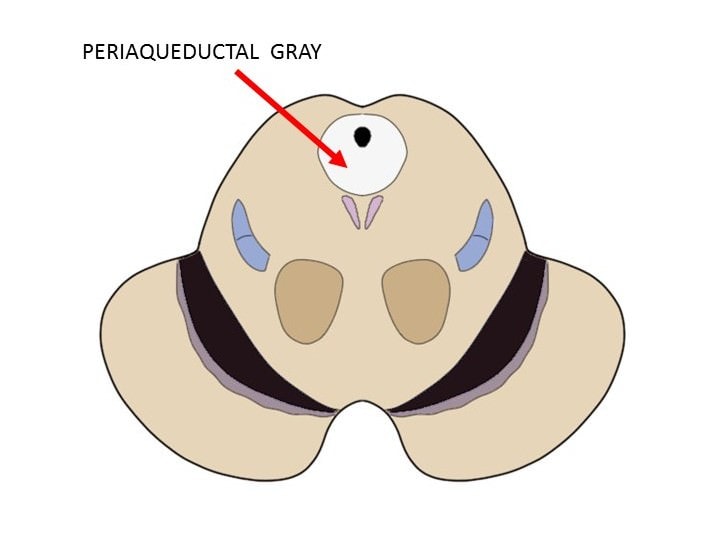Know Your Brain: Periaqueductal Gray
Where is the periaqueductal gray?

The periaqueductal gray, or PAG, is an area of gray matter found in the midbrain. The PAG surrounds the cerebral aqueduct (hence the name periaqueductal) and occupies a column of brainstem that stretches about 14 mm long. There are no obvious visible anatomical divisions within the PAG, but researchers have divided the PAG into four columns based on differences in connectivity and function: the dorsomedial, dorsolateral, lateral, and ventrolateral columns. For the sake of simplicity, however, below I will discuss the PAG as a whole instead of partitioning it using this columnar organization.
What is the periaqueductal gray and what does it do?
Although the functions of the PAG are complex and not fully understood, since the 1970s it has best been known for its role in the inhibition of pain. Indeed, some have argued that its identification as an "analgesia center" has hindered a more complete understanding of the functions of the PAG. An increasingly intricate appreciation of PAG function, however, has been emerging over the past few decades
When the PAG was first found to have an association with pain, it was observed as playing a role in pain transmission---or the sending of pain signals to the cortex---and not the mitigation of those signals. Eventually, the PAG would come to be much better recognized as an area important to pain inhibition. In the late 1960s, the first indication of the role of the PAG in pain suppression emerged from a study that found that stimulation of the PAG in rats allowed researchers to perform surgery on the rats without the use of anesthetics (and without the animals exhibiting signs of severe pain). Further studies found that PAG activation was associated with the inhibition of spinal cord neurons involved in pain signaling. By the mid-1970s, stimulation of the PAG was already being used as an experimental approach to treating chronic pain in human patients. The fact that some of these experiments reported success in the treatment of chronic pain supported the role of the PAG in analgesia. The patients involved in these experiments also often complained of a wide range of side effects linked to PAG stimulation, however, suggesting that many more functions than analgesia were connected to the PAG.
Still, due to the seminal findings involving the PAG and pain reduction, the PAG became best known for its role in analgesia. Although this has been a recognized function of the PAG for several decades, the full complexities of the mechanism underlying PAG-facilitated analgesia are still not completely understood. The main pathway seems to involve neurons that project from the PAG to nuclei of the medulla---primarily the raphe nuclei, which are clusters of serotonin-producing neurons. Activated raphe neurons project down to the spinal cord where they inhibit neurons in the dorsal horn of the spinal cord that are responsible for transmitting pain signals. This pathway seems to be involved in a variety of pain inhibition responses, including analgesia experienced during acutely stressful events and the pain relief we obtain from taking opioid painkillers.
Interest in the PAG's role in pain inhibition has caused the other known functions of the PAG to often be overlooked; it's clear, however, that the PAG is involved in much more than just analgesia. For example, the PAG appears to play a part in the regulation of heart rate and blood pressure, and it is thought that the PAG may help to adjust cardiovascular activity in the context of particular emotional experiences. The PAG also seems to contribute to a number of other autonomic processes, and it is important to the control and contraction of the bladder in humans and other animals. The PAG plays a role in the production of vocalizations; stimulation of the PAG can elicit vocalizations in animals and lesions of the PAG can disrupt them in humans and other animals. In an attempt to understand the contributions of the PAG to vocalizations, some have hypothesized that the PAG is important to coordinating respiratory and laryngeal motor patterns that facilitate the production of vocalizations. The PAG also seems to be involved with emotional responses. It appears to be especially likely to be influential in the production of fearful and defensive reactions, as stimulation of the PAG can elicit these types of reactions in a variety of animals; human participants also displayed activation of the PAG when a threat came closer to them.
There are still many other functions associated with the PAG that have not been mentioned here. Thus, despite being a relatively small area of the brain, the PAG is densely interconnected with various other brain regions, and seems to be involved in a diverse range of functions. It is therefore understandable why some researchers believe calling it an "analgesia center" is representative of a limited perspective on the PAG.
References (in addition to linked text above):
Behbehani MM. Functional characteristics of the midbrain periaqueductal gray. Prog Neurobiol. 1995 Aug;46(6):575-605. doi: 10.1016/0301-0082(95)00009-k. PMID: 8545545.
Carrive P, Morgan MM. Periaqueductal Gray. In: Mai JK and Paxinos G, eds. The Human Nervous System. 3rd ed. New York: Elsevier; 2012.


